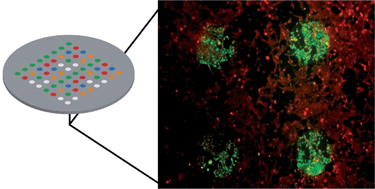In the search for new therapeutic chemicals, lab-on-a-chip systems have recently emerged as innovative and efficient tools for cell-based assays and high throughput screening. Here, we describe a novel, versatile and simple device for cell-based assays at the bench-top. We created spatial variations of porosity on the surface of a membrane filter by microcontact printing with a biocompatible polymer (PDMS). We called such systems Micro-Printed Membranes (μPM). Active compounds dispensed on the porous areas, where the membrane pores are not clogged by the polymer, can cross the membrane and reach cells growing on the opposite side. Only cells immediately below those porous areas could be stimulated by chemicals. We performed proof-of-principle experiments using Hoechst nuclear staining, calcein-AM cell viability assay and destabilization of the cytoskeleton organisation by cytochalasin B. Resulting fluorescent staining properly matched the drops positioning and no cross-contaminations were observed between adjacent tests. This well-less cell-based screening system is highly flexible by design and it enables multiple compounds to be tested on the same cell tissue. Only low sample volumes in the microlitre range are required. Moreover, chemicals can be delivered sequentially and removed at any time while cells can be monitored in real time. This allows the design of complex, sequential and combinatorial drug assays. μPMs appear as ideal systems for cell-based assays. We anticipate that this lab-on-chip device will be adapted for both manual and automated high content screening experiments.

You have access to this article
 Please wait while we load your content...
Something went wrong. Try again?
Please wait while we load your content...
Something went wrong. Try again?


 Please wait while we load your content...
Please wait while we load your content...